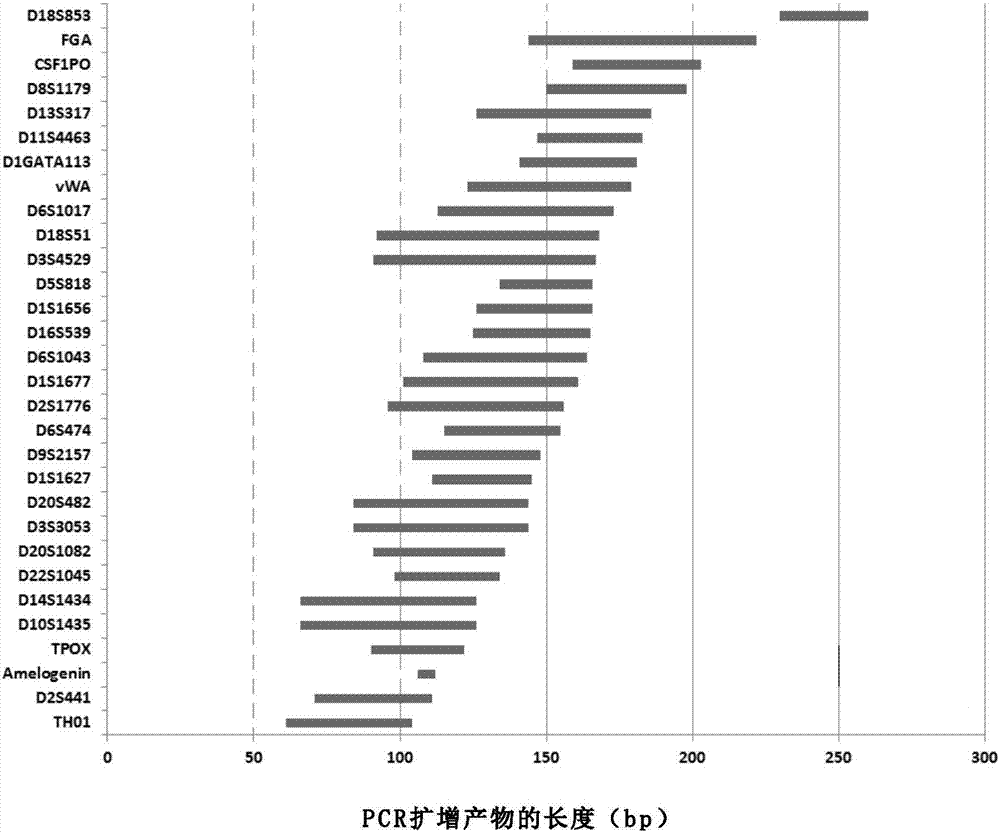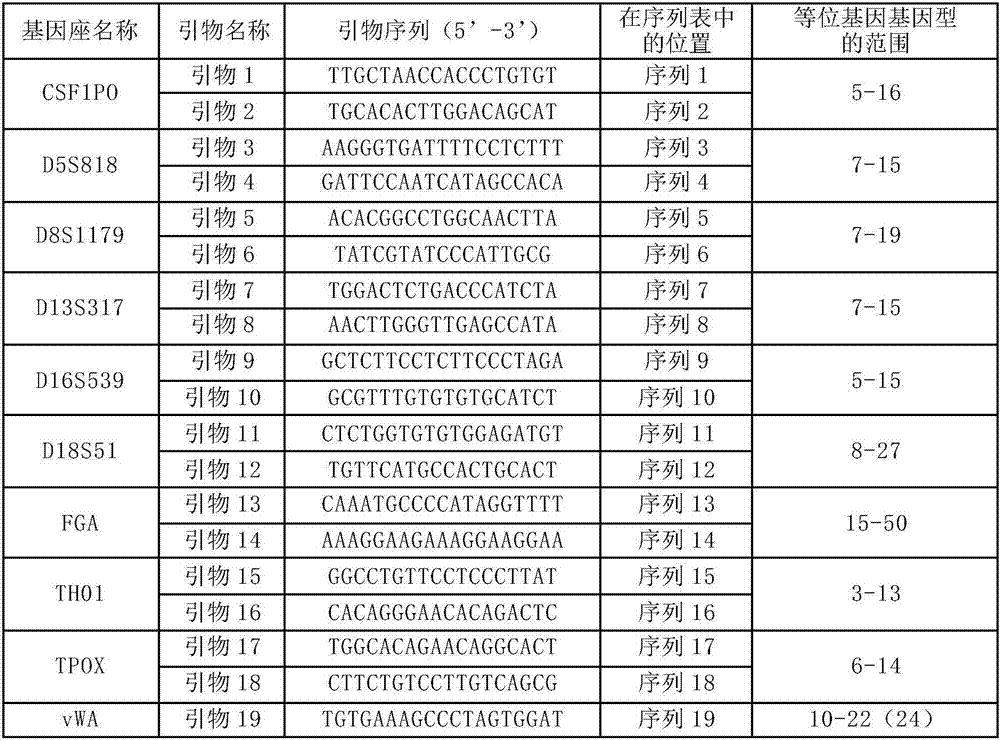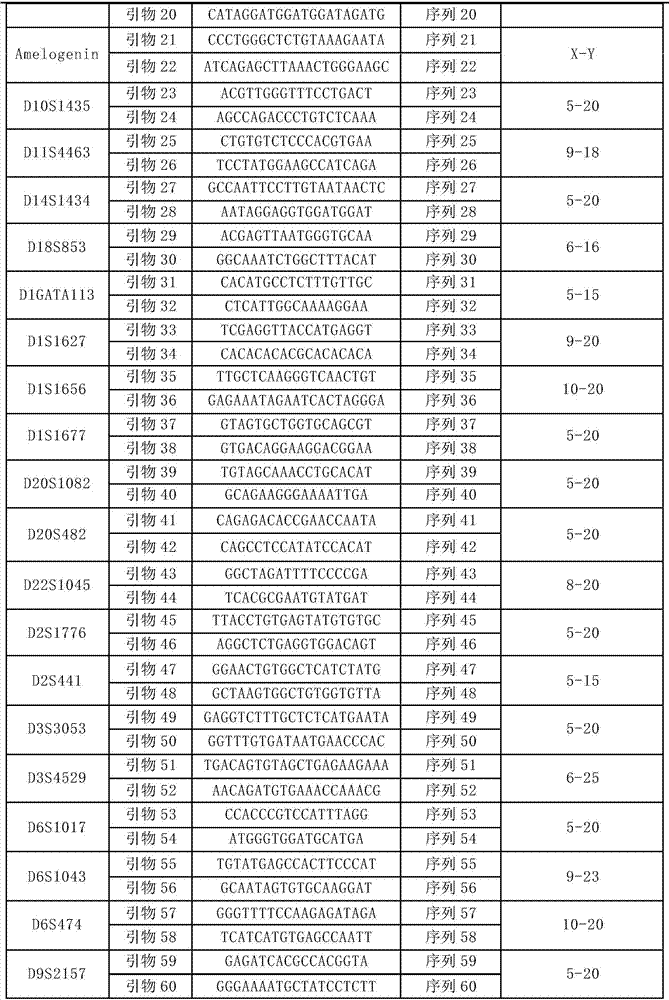Reagent kit for detecting gene loci on basis of next generation sequencing technologies and special primer combination of reagent kit
A technology of primer combination and sequence, applied in the field of forensic science, can solve the problems of unfavorable degradation specimen typing, does not support users' independent selection of STR loci, and expensive kits, etc.
- Summary
- Abstract
- Description
- Claims
- Application Information
AI Technical Summary
Problems solved by technology
Method used
Image
Examples
Embodiment 1
[0085] Example 1. Preparation of a kit for detecting loci based on next-generation sequencing technology
[0086] 1. Screening of autosomal STR loci
[0087] 1. The inventors of the present invention first screened out 50 autosomal STR loci with reference to the loci in the existing kit (such as the kit for the Illumina MiseqFGx next-generation sequencer) and the loci suitable for Chinese; Then organize the core and flanking region sequences (1000-1500bp in length) of 50 autosomal STR loci into Fasta format, and set up 9 folders, corresponding to 60bp, 80bp, 100bp, 120bp, 150bp, 200bp, 250bp, 300bp , 400bp 9 expected core fragment length gradients, each folder contains pre-arranged full-sequence FSTA files, run the GMATA Marker designing function for the FASTA files in each folder; select amplification from the primer design results A pair of primers whose product fragment length is less than 251bp, and fluorescence is added to the corresponding primers.
[0088] 2. Taking t...
Embodiment 2
[0100] Example 2. Application of the kit for detecting loci based on next-generation sequencing technology
[0101] 1. DNA sample preparation
[0102] Take the standard 2800M and dilute it with ultrapure water to obtain a standard 2800M aqueous solution with a concentration of 1ng / mL.
[0103] 2. Library preparation
[0104] 1. PCR amplification
[0105]Using the standard 2800M aqueous solution obtained in step 1 as a template and the primer mixture prepared in step 3 of Example 1 as primers, PCR amplification was performed to obtain PCR amplification products.
[0106] The reaction system is 20 μL, which consists of 10 μL Master Mix (product of the Physical Evidence Identification Center of the Ministry of Public Security), 9 μL primer mix and 1 μL standard 2800M aqueous solution. In this reaction system, the concentration of primer 3, primer 4, primer 9, primer 10, primer 17, primer 18, primer 31, primer 32, primer 43, primer 44, primer 49 and primer 50 was 0.05 μM. 2. P...
Embodiment 3
[0120] Example 3. Verification of the accuracy of the kit for detecting loci based on next-generation sequencing technology
[0121] Take 1ng of the standard product 2800M, and perform capillary electrophoresis detection according to the instructions of the GlobalFiler PCR Amplification Kit to obtain the allelic genotype of the locus. The typing results are detailed in column 2 of Table 4.
[0122] The standard product 2800M was detected according to the steps in Example 2 to obtain the allelic genotype of the locus. The typing results are detailed in column 3 of Table 4.
[0123] The results showed that the genetic locus overlapped by the next-generation sequencing technology-based detection locus kit prepared in Example 1 and the GlobalFiler PCR Amplification Kit had exactly the same typing results in the standard 2800M sample.
[0124] Table 4
[0125]
[0126]
[0127] Note: "-" indicates absence; "'" indicates different subtypes of alleles, see Table 3 for detail...
PUM
 Login to View More
Login to View More Abstract
Description
Claims
Application Information
 Login to View More
Login to View More - R&D
- Intellectual Property
- Life Sciences
- Materials
- Tech Scout
- Unparalleled Data Quality
- Higher Quality Content
- 60% Fewer Hallucinations
Browse by: Latest US Patents, China's latest patents, Technical Efficacy Thesaurus, Application Domain, Technology Topic, Popular Technical Reports.
© 2025 PatSnap. All rights reserved.Legal|Privacy policy|Modern Slavery Act Transparency Statement|Sitemap|About US| Contact US: help@patsnap.com



